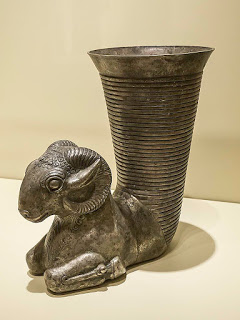
Thread: Engraving on an Ostrich Egg from Mycenae, Greece. From great text: "Ostrich egg-shell cups of Mesopotamia and the ostrich in ancient and modern times" archive.org/details/ostric…
Is this just a random scene or were the animals deliberately arranged like this?
Is this just a random scene or were the animals deliberately arranged like this?

In my article "Symbols of the seasons" I talked about animal markers for 4 seasons:
oldeuropeanculture.blogspot.com/2019/10/symbol…
Ram: Spring (Feb-Apr)
Bull: Summer (May-Jul)
Lion: Autumn (Aug-Oct)
Goat: Winter (Nov-Jan)
oldeuropeanculture.blogspot.com/2019/10/symbol…
Ram: Spring (Feb-Apr)
Bull: Summer (May-Jul)
Lion: Autumn (Aug-Oct)
Goat: Winter (Nov-Jan)

This has to do with mating and birthing seasons of these animals...Lambing of wild Eurasian sheep (Spring), Calving of wild Eurasian cattle (Summer), Mating of Eurasian lions (Autumn), Mating of wild Eurasian goats (Winter)...
These are most common symbols of the seasons though
These are most common symbols of the seasons though
In my article about the symbols of the seasons, I mention that if you wanted to represent all seasons as grazing animals, then the symbol for autumn would be deer, which mates in autumn...
Achaemenid rhytons (1st millennium BC) depicting ram, bull, deer, goat...



Achaemenid rhytons (1st millennium BC) depicting ram, bull, deer, goat...




So if we look at the Mycenaean ostrich egg scene, we can see that from right to left:
Ram: Spring
Bull: Summer
Deer: Autumn
What's missing is Goat: Winter
But what about the lion(s)?
Ram: Spring
Bull: Summer
Deer: Autumn
What's missing is Goat: Winter
But what about the lion(s)?
In this thread I asked a question: was lion, apart from being symbol of autumn, maybe a symbol of the whole hot sunny dry part of the year? Being a solar symbol linked with the sun's heat (the hottest part of the year in the northern hemisphere is Leo)
https://twitter.com/serbiaireland/status/1358093514458996738
This would then explain why on the Mycenaean scene we have a lion depicted in all three panels depicting three sunny seasons: spring, summer, autumn. 

But there is one more interesting detail on this image. I think that this scene actually depicts a specific moment in the solar year. The end of summer and beginning of Autumn. Leo. The hottest part of the year. Why would I think so?
You see how both Ram-Spring and Bull-Summer are attacked by lions, but Deer-Autumn is still roaming free???
• • •
Missing some Tweet in this thread? You can try to
force a refresh















